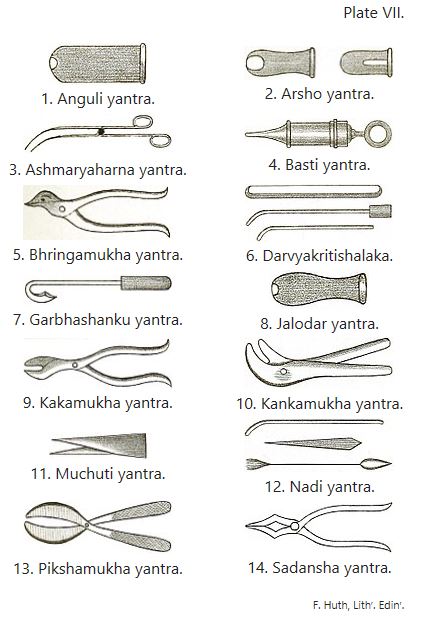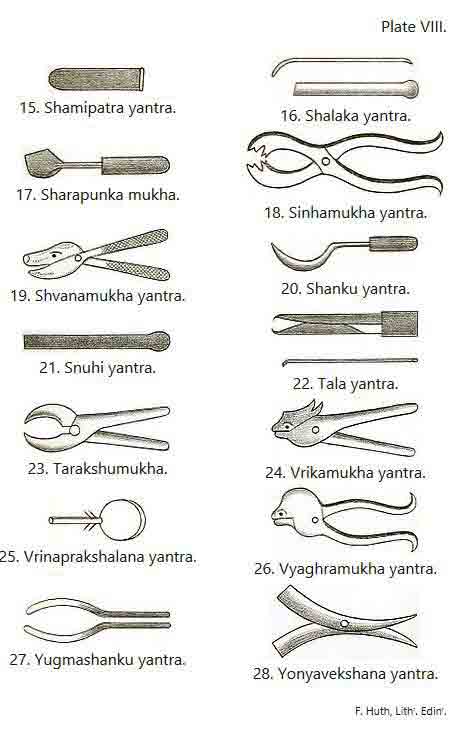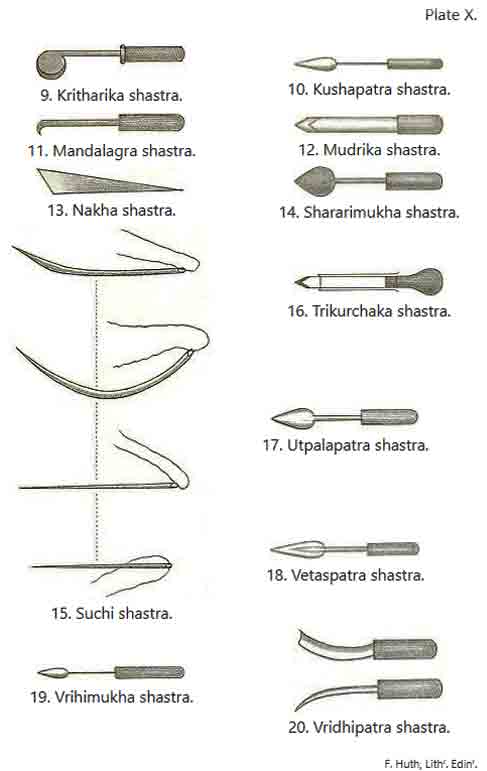
Surgery In Ancient India— Its Rise and Fall

|| Index || Chapter 1 || Chapter 2 || Chapter 3 || Chapter 4 || Chapter 5 || Chapter 6 || Chapter 7 || Chapter 8 || Chapter 9 || Chapter 10 || Chapter 11 || Concluding Remarks || Bibliography
Do you know that many ideas for the present-day plastic surgery, such as the transplanting of sensible skin flaps came from ancient Indians? The following article shows the progress achieved by ancient Indians in the field of surgery 2000-3000 years ago.
SHALYA or Surgery is, as noted in the earlier part of the work, one of the eight departments of Ayurveda. In the work of Sushruta, it occupies the first place. Medicine and Surgery, though parts of the same science, are treated as distinct branches. Charaka, Atreya, Hartia, Agnivesha, and others, are accepted as guides more in medicine than in surgery; while Dhanvantari, Sushruta, Aupadhenava, Aurabhra, Paushkalavata, and others, were rather surgeons than physicians, having written elaborate works on the art of healing by mechanical and instrumental means. In a case requiring surgical operations, the physician says to his patient, " Atra Dhanvantarinam adhikaras kriyavidhau," meaning, "It is for the surgeon to take in hand this case."
It is true the ancient surgery did not reach that perfection to which the modern science has attained. The successes of modern surgery are admitted on all hands to be prodigious, but that should not detract from the credit due to the ancients. The stock of surgical instruments and appliances used by the ancients was no doubt very small and meager as compared with the armamentarium of a surgeon of the nineteenth century.
The reason assigned for this fact is that the instruments they used were enough for their requirements, and that their acquaintance with the properties and virtues of drugs was so very great that most of the diseases and injuries now dealt with by the surgeon were then cured medicinally. An abscess, for instance, was either made to subside by certain kinds of plaster, or the swelling was assisted to mature by means of poultices, and when ripe was opened, not always with the knife, but by the application of a mixture of Danti, Chitrak, Eranda, and some other drugs.
Cases of urinary calculi were treated with anti-lithics, and diuretics were administered so as to act as solvents for the stone, and thus the necessity of cutting was, if the patient so desired, obviated. It was only in rare cases, and for effecting a speedy recovery or affording immediate relief, that they had recourse to surgical operations. And yet their earliest works mention no less than one hundred and twenty-five surgical instruments for ophthalmic, obstetric, and other operations.
They were experts in forming new ears and noses. This operation has been practiced for ages in India, where cutting off the nose and ears was a common punishment, and "our modern surgeons have been able to borrow from them (Hindus) the operation of rhinoplasty" (Weber). On this subject Dr Hirschberg of Berlin says, "The whole plastic surgery in Europe had taken its new flight when these cunning devices of Indian workmen became known to us. The transplanting of sensible skin flaps is also an entirely Indian method."
The same writer also gives credit to the Indians for discovering the art of cataract-couching, "which was entirely unknown to the Greeks, the Egyptians, or any other nation." The cataract operations are, it is said, performed by Indian practitioners with great success even to this day. The Hindus were also experts in performing amputations and abdominal section. They could set fractures and dislocations in men and beasts, reduce hernia, cure piles and fistulain-ano, and extract foreign bodies. Inoculation for small-pox seems to have been known to them from a very early age.
Long before Edward Jenner was born, certain classes in India, especially cow-herds, shepherds, Charanas, and the like, had been in the habit of collecting and preserving the dry scabs of the pustules. A little of this they used to place on the forearm, and puncture the skin with a needle. In consequence of this inoculation, the classes are supposed to have enjoyed a certain amount of immunity from small-pox.
Dr Huillet, late of Pondicherry, assures us that "Vaccination was known to a physician, Dhanvantari, who flourished before Hippocrates." The ancient Hindus used to practice the dissection of the human body, and taught it to their disciples. They knew human anatomy and something of physiology. "The Hindu philosophers," says Dr Wise, "undoubtedly deserve the credit of having, though opposed by strong prejudice, entertained sound and philosophical views respecting uses of the dead to the living ; and were the first scientific and successful cultivators of the most important and essential of all the departments of medical knowledge — practical anatomy."
It may as well be added that they were perfectly acquainted with the anatomy of the goat, sheep, horse, and other animals used in their sacrifices. Early warfare was conducted with such weapons as bow and arrow, sword, mace, etc. Thus, in every war the services of bold and skillful surgeons were always in requisition for extracting arrows, amputating limbs, arresting hemorrhage, and dressing wounds.
Sushruta gives very minute directions to be observed in the performance of surgical operations, and describes the method of opening abscesses, treating inflammations, boils, tumors, ulcers and fistulas, and of applying blisters, cautery, etc. The constant wars and internecine strife afforded ample opportunities to the surgeons to distinguish themselves in their profession and acquire considerable dexterity in their work. A glance at the Vedic or the Epic period will bear testimony to this fact.
The chirurgeons of yore are recorded to have performed incredible feats in surgical operations, just as modern surgery is able to do many things which ordinary folks will hardly believe to be possible. In its onward progress, modern surgery may yet be able to succeed in doing what the ancients claim to have performed. Sushruta classifies surgical operations into Aharya, extracting solid bodies ; Bhedya, excising ; Chhedya, incising ; Eshya, probing ; Lekhya, scarifying ; Sivya, suturing ; Vedhya, puncturing ; and Visravaniya, evacuating fluids.
The surgeon, before commencing an operation, is enjoined to equip himself with all the requisites, such as the instruments, salts, bandages, honey, oil, water, etc. He should have practical experience of his art, and should have seen many surgical operations performed by others. He should be intelligent, steady, skillful, and should execute his work with a light hand. He should have by his side steady and strong attendants to assist him. The patient should be allowed to take light food before any operation is performed upon him.
Abdominal operations, however, and operations in the mouth, or about the anus, should be performed when the patient is fasting. The operation should be performed with the utmost care; and after it is over, a sesamum poultice should be applied to the wound, and a cloth bandage should be tied round it. A certain incense should be kept burning In the operation room. (This foreshadows the germ theory of the present day.)
The surgeon should not leave his patient without offering a prayer to the Almighty for his speedy recovery. Particular attention is to be paid to the regimen of the patient. The wound must be dressed at regular intervals until it is all healed up. Should the wound cause intense pain, a cloth soaked in tepid ghee (clarified butter) mixed with liquorice may be applied to it.
As stated in the beginning of this chapter, the Indian surgery recognized 125 implements. They are grouped under two heads — Yantras (appliances) and Shastras (instruments). The Yantras are 105, and divided into six classes
- Svastikas, pincers or forceps, twenty-four forms
- Sandashas, tongs, of two sorts
- Talas, similar, of two kinds
- Nadis, tubular instruments like catheters, etc., of twenty varieties
- Shalakas, bougies, of thirty sorts
- Upayantras, dressings, as cloth, twine, etc., twenty-six in number.
These make a total of 104. The last, but not the least in importance, is the hand, which is rightly considered to be the best and most indispensable implement in surgical operations. For specimens of some of the implements (yantras) used in Indian surgery, refer to Plates shown below.

1. Anguli yantra. 2. Arsho yantra. 3. Ashmaryaharna yantra.
4. Basti yantra. 5. Bhringamukha yantra. 6. Darvyakritishalaka.
7. Garbhashanku yantra. 8. Jalodar yantra. 9. Kakamukha yantra.
10. Kankamukha yantra. 11. Muchuti yantra. 12. Nadi yantra. 13.
Pikshamukha yantra. 14. Sadansha yantra.

15. Shamipatra yantra. 16. Shalaka yantra. 17. Sharapunka mukha.
18. Sinhamukha yantra. 19. Shvanamukha yantra. 20. Shanku yantra.
21. Snuhi yantra. 22. Tala yantra. 23. Tarakshumukha. 24. Vrikamukha
yantra. 25. Vrinaprakshalana yantra. 26. Vyaghramukha yantra. 27.
Yugmashanku yantra. 28. Yonyavekshana yantra.
The Shastras (instruments) are twenty in number, and are shown on Plates IX.-X. They are : — (1) Ardhadhara, (2) Atimukha, (3) Ara, (4) Badisha, (5) Dantashanku, (6) Eshani, (7) Karapatra, (8) Kartarika, (9) Kritharika, (10) Kushapatra, (ll) Mandalagra, (12) Mudrika, (13) Nakhashastra, (14) Shararimukha, (15) Suchi, (16) Trikurchaka, (17) Utpalapatraka, (18) Vriddhipatra, (19) Vrihimukha, and (20) Vetaspatra.

1. Ardhadhara shastra. 2. Atimukha shastra. 3. Ara shastra.
4. Badisha shastra. 5. Dantashanku shastra. 6. Eshani shastra. 7.
Karapatra shastra. 8. Antarmukha kartarika. 10. Kushapatra shastra.
11. Mandalagra shastra. 12. Mudrika shastra. 13. Nakha shastra.
14. Shararimukha shastra. 15. Suchi shastra. 16. Trikurchaka shastra.
17. Utpalapatra shastra. 18. Vetaspatra shastra. 19. Vrihimukha
shastra. 20. Vridhipatra shastra.
The dimensions of these instruments are given in detail by old writers, who at the same time recommend that new implements and instruments should be introduced in accordance with the exigencies of the time and with the advice of experienced and competent surgeons. It is also enjoined that the instruments should be made of the best steel, for the manufacture of which India has been celebrated from the remotest times; they should be well shaped, with sharp, flawless edges, and should be kept in handsome, portable wooden boxes, with a separate compartment for each instrument.
The surgical operations are performed on what are considered auspicious days. The patient is made to sit or stand with his face to the east, the surgeon before him with his face to the west. The surgeon should be cautious that no vital part, artery, vein, joint, or bone is carelessly injured in the course of the operation, and that the instrument does not go deeper than the requirements of the case actually demand. In serious surgical operations, and in diseases of a painful nature, the patient was made insensible by the administration of anesthetics.
In cases of children, or of patients having a dread of the knife, or where the proper instruments cannot be procured, bamboo, crystal, glass, Kurvinda (a kind of stone), leeches, fire, caustics, nail, Kareera (Capparis aphylla), Shefali (Vitex Negundo), hair and finger may be made use of. They are called Anushastras or substitutes. Sharp pieces of bamboo bark or pointed crystal, glass, or Kurvinda may be employed as incisive instruments. The nail may be used in extracting a solid body, leeches in extracting blood, and hair, finger or vegetable sprout for probing. Caustics are used in opening abscesses, and fire (live charcoal) is applied to snake-bites and to wounds that are intensely painful.
Thus, there are three modes adopted by the Hindus for treating surgical cases — by cutting instruments, by caustics, and by actual cautery. In the opinion of Sushruta, caustic is better than the knife, and cautery better than either. In order to acquire dexterity in surgery, the preceptors made their pupils practice different operations on various substances.
Incision, for instance, was practiced on Pushpaphala (Cucurbita maxima), Alabu (Langenaria vulgaris), Kalinda (Citrullus vulgaris), Trapu (Cucumis pubescence), and other fruits
- Evacuating on a full Drita (a leather-bag for holding water), and on the urinary organs of dead animals
- Scarification on the fresh hides of animals on which the hair was allowed to remain
- Venesection was practiced on the vessels of dead animals, and on the stalks of the water-lily
- The art of probing and stuffing on bamboo, reed, cavities of wood and on dry Alabu
- Extraction of solid bodies on Panasa (Artocarpus integrifolia), Bilva (Ægle Marmelos), Bimbi (Cephalandra indica), and on the teeth of dead animals
- "Removal of bad humors" (scraping?) was practiced on wax spread on a board of Shalmali wood (Bombax malabaricum) , and suturing on pieces of cloth, skin, or hide
- Ligaturing and bandaging were practiced on dummies
- Application of caustics and the actual cautery on pieces of flesh
- And catheterization on an unbaked earthen vessel filled with water
The art of Surgery gradually declined in India owing to a variety of causes, the chief among them being the aversion of the Brahmanas, who had the monopoly of teaching the various sciences, to animal food and to the sacrificial offerings which were too common in the pre-Buddhist period. This aversion made them shrink from touching the carcasses necessary for anatomical demonstrations. They also shrank from coming in contact with blood, pus, and other matter, which cannot be avoided in performing surgical operations. Surgery being neglected by the priestly caste, passed into the hands of the lower classes, whose practice was purely empirical. Even these people, for want of encouragement, allowed it to decline, until, as Mr Elphinstone rightly remarks, bleeding was left to the barber, bone- setting to the herdsman, and the application of blisters to every man.
Suggestions for Further Reading
- The Vimanika Shastra Index Page
- What is Hinduism?
- The Pros and Cons of the Theory of Aryan Invasion into India
- History of Atheism in Ancient India
- The Biggest Holocaust in World History
- Science and Religion in Ancient India
- Serpent or Snake Worship in Southern India
- The Interest of European Scientists in Indian Calendar and Chronology
- Yin and Yang, and the Hindu Connection
- The History, Antiquity and Chronology of Hinduism
- Creation Myths of Ancient People
- The Power of Imagination
- Essays On Dharma
- Esoteric Mystic Hinduism
- Introduction to Hinduism
- Hindu Way of Life
- Essays On Karma
- Hindu Rites and Rituals
- The Origin of The Sanskrit Language
- Symbolism in Hinduism
- Essays on The Upanishads
- Concepts of Hinduism
- Essays on Atman
- Hindu Festivals
- Spiritual Practice
- Right Living
- Yoga of Sorrow
- Happiness
- Mental Health
- Concepts of Buddhism
- General Essays
Source: Chapter 10, A Short History Of Aryan Medical Science By H.H. Sir Bhagvat Singh Jee, K.C.I.E. M.D., D.C.L., Ll.D., F.R.C.P.E. Thakore Saheb Of Gondal With Ten Plates, London Macmillan And Co., Ltd. New York : The Macmillan Company 1896. This was previously edited by Rajasekhar, 1961, and was reformatted and reorganized for the web edition by Jayaram V in 2019. The title of the work has also been changed to A Short History Of Indian Medical Science to reflect the current theories of the early history of India and adjoining areas.